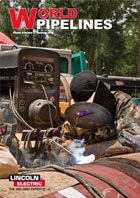Editorial comment
Push the boat out‘Brazil needs boats’ is the starting point of my nautical-themed comment this month, because recently I have read a veritable raft of news stories and reports about new pipelay and support vessels bound for Brazil.Subsea 7 S.A. announced in late October that it had been awarded two contracts from Petrobras (worth a combined US$ 600 million) for operation of the pipelay support vessels Seven Mar and Seven Condor for three years offshore Brazil. Subsea 7 will project manage and provide engineering for the installation of pipelines, flowlines, umbilicals and equipment.
Register for free »
Get started now for absolutely FREE, no credit card required.
Also heading for Brazilian waters is IHC Merwede’s newly launched flexible pipelay vessel, the Sapura Diamante. The 550 t vessel, commissioned by Sapura Navegação Marítima – a joint venture between Sapura Kencana and Seadrill – is the first of five fully integrated offshore vessels to be delivered. The Sapura Diamante will be used to develop deepwater Brazilian oilfields. It will be equipped with a pipelay spread from IHC Engineering Business, comprising two below-deck storage carousels, a vertical, tiltable lay system with 550 t top tension capacity and a full automation system.
Petrobras, well aware that global demand for pipelay and pipelay support vessels is pushing upwards, is keeping up its chartering programme for the largest units of the batch. Demand for pipelay vessels is expected to increase by 10% over the next couple of years (88 actual vessels were in operation in 2012).
In seafaring news elsewhere, in October Ceona (UK) awarded a five year contract worth £45 million to ROV provider ROVOP (UK). ROVOP will provide hydraulic ROV services onboard Ceona’s fleet of new, purpose-built pipelay and construction vessels, including the Ceona Amazon and the Polar Onyx. The Ceona Amazon boasts exceptional sea-keeping characteristics, making it ideal for operations in remote and challenging locations. The multi-layer vessel is a large, multi-functional, dynamically-positioned pipelay and construction vessel. The vessel doesn’t require a spool base to support its operations and can be remotely operated, making it extremely well suited to overall field development. Polar Onyx is designed for operation in harsh conditions and deep waters, and both vessels are able to lay pipe to 3000 m water depth.
Also announced last month was a project 25 years in the making: a huge catamaran, to embark from a South Korean shipyard in 2014, bound for redundant rigs in the UK’s North Sea. Capable of lifting the equivalent of four Eiffel Towers (48 000 t), Allseas’ Pieter Schelte will be tasked with decommissioning North Sea oilrigs. The vessel is named after Pieter Schelte Heerema, the father of Allseas Group Chief Executive Edward Heerema. Here’s how it works: the ship sails up to the oilrig, guiding the steel platform above the water between its two jutting hulls (remember, it is shaped like a traditional catamaran, albeit on a grand scale!) Hydraulic clamps stick to the subsea parts of the platform, which is then lifted and carried to shore. Speaking to press in October, Edward Heerema said “This is the biggest bet of my career”. David Thomas, Market Analyst at Credit Suisse, said “I don’t see the Schelte being anything other than a one-off, but by taking the risk they’ve cornered the market in advance.”
Finally, Krylov State Research Centre in Russia, has developed a conceptual design for a pipelaying ship. Envisaged for operation in the brutal Barents, Pechora and Kara Seas, the conceptual pipelay vessel could lay concrete coated or flexible pipelines to depths of 500 m, from a centrally-positioned stinger in the middle part of the hull, especially designed for ice protection. For a look at the new design, and a chance to see the giant catamaran plans too, please visit www.energyglobal.com
One last snippet: did you know you can track pipelay vessels by last known co-ordinates, or by satellite signal? A host of ship-spotting and vessel-finding websites offer positioning information. Want to find out what Seven Condor is doing? A quick internet search will give you the exact location of the vessel. Why not shake a leg and give it a try?


